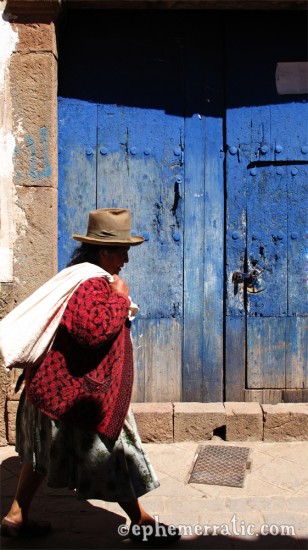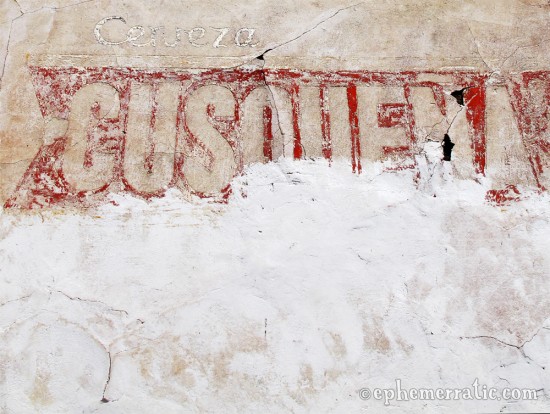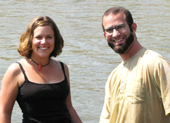Buzz kill bus crash in Peru
First, to our friends and families: We’re fine. We were not on this bus.

This is never something you want to see, anywhere
Pisac, Peru is a small town with a central area of cobblestone streets fit only for tour groups, pedestrians, packs of dogs, donkey-drawn carts, and wheelbarrows. The charm ends at the edge of the old town, where roads widen for the large buses that bring locals and tourists alike from all over the Sacred Valley to barter at the popular open-air market.
In our wanderings around Pisac, Todd and I find ourselves on one of these wide roads, facing a battered and burned bus.
“Oh my gahd. Look at the roof. People must have died in this.”
We wonder why this frightening object has been left in view of passing tour groups, but there are no answers in the wreckage. The bus doesn’t smell like cinder or fuel, so we suspect that it has been parked for a while.

Quechua woman walks through Pisac's old town
Later, I Google “bus crash Peru” and get a morbid number of results detailing an even more morbid frequency and severity of accidents. Blame seems apportioned equally to bus companies, shoddy maintenance, negligent or speeding drivers, poor road conditions, treacherous weather, and government corruption.
I finally find the Pisac bus in the search results. Three died and dozens were injured in the accident, which happened over a month previously. Literally adding insult to injury, the bus was uninsured, leaving survivors burdened by the cost of medical care.

Old Cusqueña ad
Todd and I disagree over whether we should share negative travel stories like this. Bad things can happen on the road or at home. He’s worried we’ll reinforce the fears people have about travel, helping to justify staycations, chorecations, and disneycations. Just no.
I hope that, if told as “The Lesson We Learned So You Don’t Have To,” such travel stories can show circumstances in which some precautionary preparation—rather than fear—is justified. But, I’m a planner; that’s how I think.
So, here it is:
“The Lesson We Learned So You Don’t Have To”
Looking at that bus, I got serious agita. For our brief Peru trip, we cockily didn’t buy travel insurance, as we did during our much longer round-the-world trip. I hadn’t signed up for California’s self-employed disability insurance. And, the benefits of our medical insurance are so paltry that we jokingly call it our “hit by a bus” coverage, since that’s the only time it would be worth using.
When I realized that that medical insurance was the only thing covering our fragile, mortal asses, the nickname wasn’t so funny anymore.
So, unless you’re so agoraphobic or fat that you can’t leave the house, you’re going to be on the road. Get travel insurance.
Comfort from the World Bank? Really?
Obviously, there’s risk involved when taking transportation anywhere in the world. Though the rate of traffic-related deaths in the U.S. is about half that of Peru, if you really want to limit your risk, head for the Marshall Islands where there are few roads and so, few fatal accidents.

Just look at those braids.
In the U.S., except for MADD campaigns, we just don’t leave the evidence sitting around city streets like a billboard for traffic safety. But, maybe that’s it. Perhaps the bus was left out for all to see to proclaim that it’s time for things to change in Peru.

Simple. Safe. Not in motion.
Rooting through my Google results, I find mention of a $150 million World Bank loan for a project aimed at improving Peru’s highways. That money won’t make Peruvian government officials put down their pisco sours and enforce existing regulations, like the one Peru does have that requires bus companies to carry insurance.
But, having ridden on Peru’s largely unpaved, uneven, safety rail-less unlit hairpin switchback roads, fixing a few of them will be a remarkable step toward safety.
___
Do you think this story should have been told? Or should I have kept quiet?


Wow, what a moving story.
Thanks Brock. It was an eye-opening moment.
I went to Mollendo to meet Mica from KayPachaTravels and she was so late I couldn’t figure out why. Her bus also crashed and they had to get on a new one with all the bloody passengers. She kept asking to call the police but of course no one wanted to report it.
And that was on one of the first class buses. The roads definitely need improvement in Peru.
Ugh, that must have been a frightening experience for Mica. The new bus should have headed straight to a hospital.
I wonder if they do any factoring in of unreported accidents in the traffic stats. My guess: no.
Why on earth should you keep quiet about things like this? We are bound by the laws of each country we visit and the least we can expect is for them to adhere to them too. The more publicity these events receive, the more pressure will be placed on local authorities to fulfill their responsibilities to locals AND tourists. Too many people die in places where they really shouldn’t. Good article.
Preach it Chris! Silence can be complicit and speaking out is one of the ways to garner attention to an issue and, hopefully, bring about change. There’s the saying “money talks” and tourists can use their tourist dollars to speak up about issues like these (and bloggers our blogs!).
Just stumbled on your site (we’re going to Peru in a few days), loving it! (We were in Barcelona a few years ago, and while our stories are a little tamer – I think we have about ten years on y’all? – we also absolutely loved it.)
One thing I did want to mention about this post and the World Bank assistance, though: safety rails. It turns out that they may not actually help! I don’t have the link at my fingertips, but there have been a few recent studies indicating that adding guard rails to twisty mountain roads may actually INCREASE fatalities. Apparently they give people an unjustified sense of security, and the average driving speed goes up; meanwhile, most guard rails can’t actually stop a car/bus/truck from going over the edge – a rail that actually could would use up that $150 million in a mile or two.
Yowzers, thanks for that fact Marc. It makes sense in a twisted, aren’t-drivers-ridiculous sort of way. I’ve gone and done a strikethrough on safety rails in the post!
There was a small study about bike helmet safety that showed that car drivers are less cautious around bike riders that wear helmets. And, some bike riders become less cautious when helmeted. (That said, I still wear my helmet but watch out for cars.)